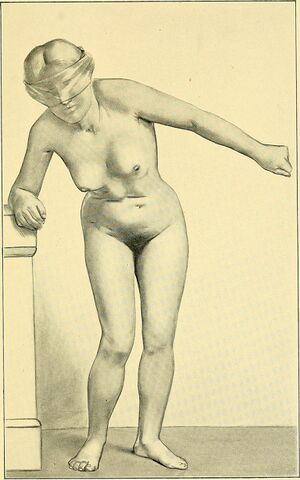Hemiplegia
Introduction[edit | edit source]
Hemiplegia is paralysis of the muscles of the lower face, arm, and leg on one side of the body. In addition to motor problems other losses may occur eg.sensation, memory, cognition. The most common cause of hemiplegia is stroke, which damages the corticospinal tracts in one hemisphere of the brain. Other causes of hemiplegia include trauma eg. spinal cord injury; brain tumours; and brain infections.
Hemiplegia is treated by addressing the underlying cause and by various forms of therapy to recover motor function. In particular, motor function in a hemiparetic limb may be improved with physical therapy and with mirror therapy. [1]
Hemiplegia is often used interchangeably with hemiparesis as both produce similar symptoms. An individual living with hemiparesis experiences a weak paralysis on one side of the body, while hemiplegia may cause the person to experience full paralysis on one side of their body, as well as difficulty breathing or speaking.[2]
Etiology[edit | edit source]
- Vascular - Cerebral hemorrhage , Stroke , Diabetic Neuropathy.
- Infective - Encephalitis , Meningitis , Brain abscess.
- Neoplastic - Glioma - meningioma
- Traumatic - Cerebral lacerations , Subdural Hematoma . Rare cause of hemiplegia is due to local anaesthesia injections given intra arterially rapidly , instead of given in a nerve branch .
- Congenital- Cerebral palsy
- Disseminated - Multiple Sclerosis
- Psychological - Parasomnia (Nocturnal hemiplegia).[3]
Signs and Symptoms of Hemiplegia[edit | edit source]
Symptoms of hemiplegia range from one person to another and are dependent on the severity of the condition. Symptoms of hemiplegia include:
- Impaired motor skills
- Difficulty grasping or holding on to objects
- Weakness of muscles or stiffness on one side of the body
- Permanently contracted muscles or muscle spasticity
- Poor balance
- Difficulty walking[2]
Treatment[edit | edit source]
People living with hemiplegia usually undergo a combination of rehabilitation therapy, which typically involves physical therapists, mental health professionals, and rehabilitation therapists.[2]
Physiotherapy[edit | edit source]
See
- Stroke: Physiotherapy Treatment Approaches
- Physiotherapy Treatment Approaches for Individuals with Cerebral Palsy
- Physiotherapy Management of Traumatic Brain Injury
References[edit | edit source]
- ↑ Btiannica Hemiparesis Available:https://www.britannica.com/science/hemiplegia (accessed 19.8.2021)
- ↑ 2.0 2.1 2.2 Hemiplegia – Types, Causes, Symptoms and Treatmentt Available:https://healthtian.com/hemiplegia/ (accessed 19.8.2021)
- ↑ Hemiplegia Dr. V.S.Nandakumarhttps://www.slideshare.net/danny14871/hemiplegia-43636165 (accessed 29 June 2018)







